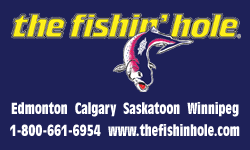Helpful Information
Sportfish of Alberta

Lake Sturgeon
Lake Sturgeon are a Threatened Species due to population size and concerns with viability. They have a zero possession limit across the province - IF YOU CATCH THIS FISH YOU MUST RELEASE IT.
Lake Sturgeon have a large brown or grey body covered with tough, leather-like tissue and five rows of bony plates. They have a shark-like, upturned tail and a pointed snout with four barbels.
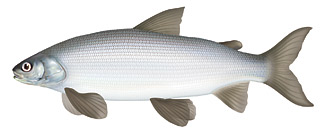
Lake Whitefish
Lake Whitefish are olive-green to blue on the back, with silvery sides. They have a small mouth below a rounded snout, and a deeply forked tail.
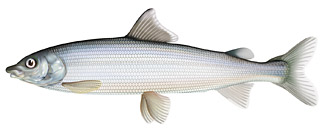
Mountain Whitefish
Mountain Whitefish have large scales, no spots and small mouths with no teeth. Their general body colour is a bronze-white or greenish white.

Northern Pike
Northern Pike are a long, slender fish with duck-like jaws and a long, flat head. The back and sides are predominantly dark green to olive green, with yellow to white spots.
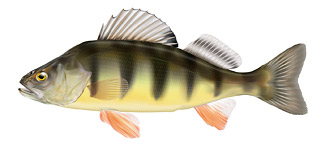
Yellow Perch
Yellow Perch are golden yellow or green, with broad, dark vertical bands on their sides. They also have needle-like spines on the dorsal fin.
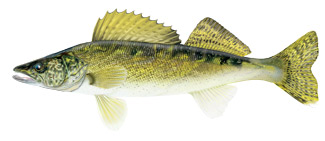
Walleye
Walleye have two distinct fins on their back, the first with large spines. They have a yellow-olive back, brassy, silvery sides with yellow spots, a white underside, and white on the lower lobe of the tail. Dusky vertical bars are often found on the body as well.
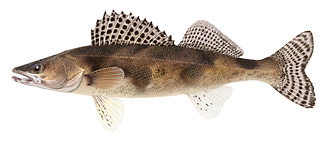
Sauger
Sauger are Sensitive in Alberta due to few occurrences, habitat degradation and being misidentified as walleye.
Sauger are golden olive on the back with silver-yellow sides and a white underside. They also have a large spiny dorsal fin, distinct rows of spots on the dorsal fins and three or four dusky vertical bars on the body.

Burbot
Burbot have a slim, brownish black body with smooth skin, a flattened head, and a fin that stretches along the back half of the body. Distinctive barbels hang from the lower jaw and nostrils.

Goldeye
Goldeye have prominent eyes with bright yellow pupils, a blunt head, and a deep, compressed body. Their colour ranges from dark blue to blue-green on its back, with silvery or white sides.
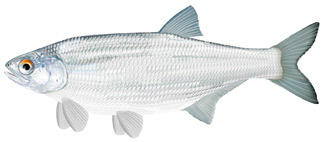
Mooneye
Mooneye and Goldeye have very similar appearance. Mooneye have prominent eyes with the top being golden, a blunt head, and a deep, compressed body with a longer keel. Their colour ranges from grey-blue to silver back with silvery or white sides.
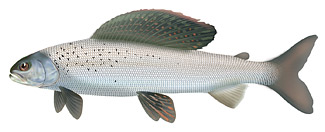
Arctic Grayling
Arctic Grayling are a Species of Special Concern due to
overharvest and passage barriers. They have a zero possession limit across the province - IF YOU CATCH THIS FISH YOU MUST RELEASE IT.
Arctic grayling can be identified by their colourful and very large dorsal fin and by their large scales with brown or black spots on the body behind the head.
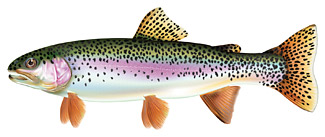
Rainbow Trout
Athabasca rainbow trout are the only strain native to alberta and are found in the Upper Athabasca watershed. They are a Threatened Species due to habitat degradation and overharvest and have a zero possession limit.
Rainbow Trout are olive-green in color with heavy black spotting over the body. Adult fish have a red-coloured stripe along the lateral line, from the gills to the tail.
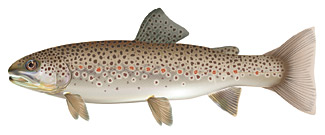
Brown Trout
Brown trout are golden brown in colour with large black spots on the back, and red spots (some with pale haloes) on the sides. They are the only trout with both red and black spotting.
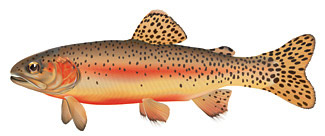
Golden Trout
Golden trout are the most colourful of trout, with an olive-green back and bright red-to-gold sides and belly.
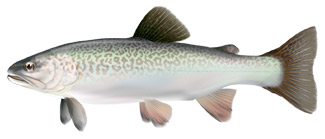
Tiger Trout
The tiger trout is a sterile hybrid from crossing brown trout eggs and brook trout milt. Tiger trout can be light to dark in colour and have pronounced vermiculations like the stripes of a tiger.
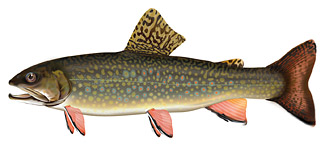
Brook Trout
Brook trout are among the most colourful trout. The back is dark green with pale wavy lines, while the sides have a purple sheen with blue-haloed red spots.
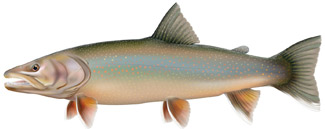
Bull Trout
Bull Trout are a Threatened Species due to small population and concerns of viability. They have a zero possession limit across the province - IF YOU CATCH THIS FISH YOU MUST RELEASE IT.
Bull trout are slim fish with a large head. Their back is olive-green to grey while their sides are silvery and marked with pale yellow to red spots. There are no black spots on the dorsal fin.
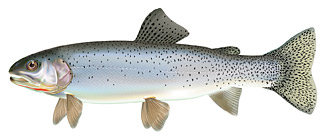
Westslope Cutthroat Trout
Westslope Cutthroat Trout are a Threatened Species due to hybridization, a reduced native range (within the S. Saskatchewn R basin) and concerns of viability. Stocked populations outside of their native range are not threatened.
Cutthroat trout are named for the bright red-orange streak in the fold under the mouth. They also have small scales and black spots without haloes on the sides.
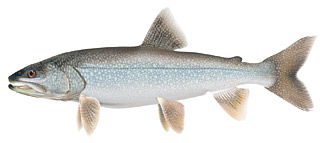
Lake Trout
Lake Trout are a Sensitive Species due to being limited to a few lakes.
Lake Trout are a grey fish with irregular white spots and a forked caudal fin.
Remember, If you don’t know, let it go!
Learn more about fish identification on mywildalberta.ca, or visit albertanativetrout.com for tips on identifying native trout.
For more information, please see Alberta’s Species at Risk and Fisheries Management status websites: www.alberta.ca/species-at-risk.aspx or https://www.alberta.ca/fish-wildlife.aspx
Trout Identification
The following illustrates important characteristics for identifying common trout species. Alberta’s Fish Identification web site is found at mywildalberta.com.
Trout (true trout and char) - rayless fleshy lope on back behind dorsal fin (adipose fin) and small scales on body
TROUT - BLACK SPOTS ON SIDES
Brown Trout

– pale haloes around large black spots
on back and body
– red spots on sides
Cuthroat Troat

– no halos around black spots
– red-orange slash under the jaw
Rainbow Trout

– no halos around black spots
– no red-orange slash under the jaw
CHAR - NO BLACK SPOTS ON SIDES
Bull Troat

– no spots or markings on dorsal fin or tail
– pale yellow to red spots on the body
Lake Trout

– pale spots on body and dorsal fin
– tail deeply forked
– lower fins have a pale leading edge
Brook Trout

– black markings on dorsal fin
– slightly forked tail
– lower fins have a black stripe behind a pale leading edge




